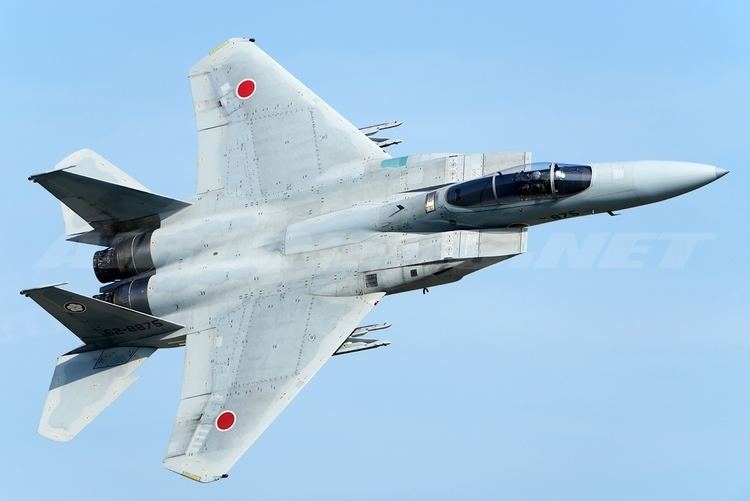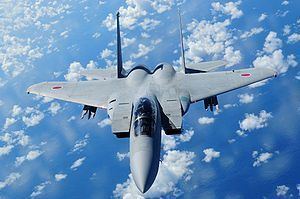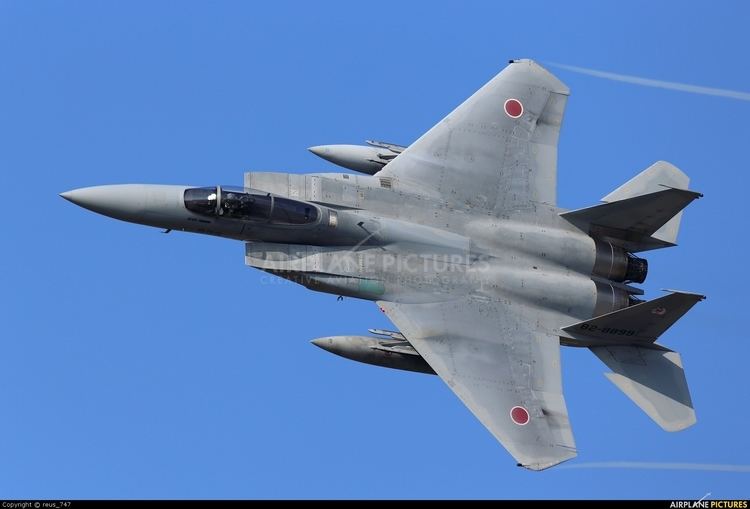Wingspan 13 m Introduced 7 December 1981 | Length 19 m Engine type Pratt & Whitney F100 | |
 | ||
Manufacturers | ||
The Mitsubishi F-15J/DJ Eagle is a twin-engine, all-weather air superiority fighter based on the McDonnell Douglas F-15 Eagle in use by the Japan Air Self-Defense Force (JASDF). The F-15J was produced under license by Mitsubishi Heavy Industries. The subsequent F-15DJ and F-15J Kai variants were also produced. Japan is the largest customer of the F-15 Eagle outside the United States. In addition to combat, F-15DJ roles include training. The F-15J Kai is a modernized version of the F-15J.
Contents
- Mitsubishi f 15j
- Development
- Design
- Improvements and upgrades
- Variants
- Operators
- Specifications F 15J
- References

Mitsubishi f 15j
Development

In June–July 1975, the Japan Defense Agency (JDA, now Ministry of Defense) examined the McDonnell Douglas F-15 Eagle as one of the 13 candidates for the replacement of the F-104J/DJ Starfighter and F-4EJ Phantom II. A single-seat F-15C and a twin-seat F-15D were evaluated at Edwards Air Force Base, and in December 1975, the F-15 was announced the winner, with the government intending to purchase 187 F-15J/DJs. By April 1978, Mitsubishi Heavy Industries was designated as the primary contractor and licensing for the F-15C/D was achieved.

After congressional review, the Department of Defense (DoD) withheld the aircraft's electronic warfare and engine systems from the licensing. Initially, the aircraft were produced in the U.S. and exported to Japan. This initial export production contributed to aircraft development under the defense industry of Japan while facilitating base production of aircraft, achieving the goal of producing a fighter to Japan's requirements.

The Japan Air Self-Defense Force (JASDF) acquired 203 F-15Js and 20 F-15DJs, of which 2 F-15Js and 12 F-15DJs were built by McDonnell Douglas in St. Louis, Missouri. Dubbed the "Peace Eagle" by the DoD FMS program, the first F-15J built in St. Louis was delivered to the United States Air Force for its first flight on 4 June 1980, and a subsequent cruise on 15 July to Japan. Additionally, 8 F-15Js were manufactured in large components and shipped to Japan for final assembly by Komaki of Mitsubishi, the first of these (serial number 12–8803) making its maiden flight on 26 August 1981. Companies divided the remainder share and produced it under license from 1981, with final assembly of aircraft performed by Mitsubishi.

In 1980, the Japanese government applied for access to advanced technology through the U.S.-Japan Forum (S&TF) but this was rejected. The JDA and the DoD held annual meetings about relaxation of the regulation after a program was started. In these meetings, the DoD official gave an answer that permitted access to initially prohibited technology of various types including composite material.
In the latter period of 1981, the first F-15J/DJ aircraft were sent to 202 Squadron, which was reorganized as an Eagle FTU and renamed the 23 Flying Training Squadron at Nyutabaru base on 21 December 1982. The JASDF developed a plan to form the first squadron after the KAL007 shootdown by a Soviet Su-15 on 1 September 1983. In March 1984, new F-15Js began replacing the 203 Squadron's F-104Js at Chitose Air Base, located across the La Pérouse Strait from the Soviet fighter base on Sakhalin Island.
Design
F-15J/DJs are identical to F-15C/Ds aside from the ECM, radar warning system, and nuclear equipment. The AN/ALQ-135 Internal Countermeasures System is replaced by the indigenous J/ALQ-8 and the AN/ALR-56 Radar Warning Receiver is replaced by the J/APR-4. The engine is the Pratt & Whitney F100 turbofan, produced under license by IHI Corporation. Some aircraft still have an inertial measurement unit, an old type of the Inertial navigation system. All F-15J/DJs have two UHF radios, which are also VHF capable.
The F-15J is characterized by an indigenous data link, but they do not support Link 16 FDL mounted by USAF F-15Cs. It works as a basic bidirectional link with the Japanese ground-controlled intercept network, and it is limited because it is not a true network.
Mitsubishi received the F-15C/D Multistage Improvement Program (MSIP) and in 1987 began upgrading the F-15J/DJs. Improvements included an uprated central computer, engines, armament control set and added the J/APQ-1 countermeasures set. The F100-PW-220 (IHI-220) was upgraded to the F100-PW-220E (IHI-220E) with a digital engine electronic control retrofit. Differences in appearance from earlier F-15Js include the J/ALQ-8 ICS with an ICS antenna mounted under the intake. The J/APQ-4 RWR antenna position on the F-15J/DJs is the same as F-15C/Ds, but the lens of F-15J/DJ MSIPs are black rather than white for F-15C/Ds.
Improvements and upgrades
F-15Js have been equipped with the Japanese-built AAM-3 missile, an improved AIM-9 Sidewinder follow-on with distinctive "barbed" forward fins. Japan has been investigating an advanced fighter to replace the F-15, meanwhile the F-15J fleet is being modernised. On 28 July 2003, the first upgraded F-15J (#928) made its first flight, and it was delivered to the JASDF Air Development Test Wing on 21 October 2003.
On 10 December 2004, the Japanese Government approved a Mid-Term Defense Program (MTDP) to modernize the F-15J MSIPs over five years in accordance with new National Defense Program Guidelines. The upgrade is being implemented in phases, but ultimately the upgrade will include a new ejection seat; replaced IHI-220E engines; more powerful processor; uprated electrical generation and cooling capabilities to support more avionics and the Raytheon AN/APG-63(V)1 radar. which has been produced under license by Mitsubishi Electric since 1997. Raytheon expects the radar will ultimately be installed in 80 F-15Js. The new radar will support the AAM-4 missile, the Japanese answer to the AMRAAM.
The Ministry of Defense (MoD) requested the modernization and deployment of reconnaissance aircraft in June 2007, and it was planned to upgrade some F-15Js with synthetic aperture radar pods; these aircraft would replace the RF-4 Phantom IIs currently in service.
On 17 December 2009, the reconnaissance upgrade disappeared from the budget after the Democratic Party took power following the General Election in 2009, and priority was given instead to improvement of the F-15J and the Mitsubishi F-2. The number of F-15J upgrades was increased from 26 to 48, and the MoD purchased the part of the modernization for 38 fighters, however, the full budget for modernization is incomplete. 48 F-15Js will get a Link 16 datalink and helmet-mounted sight. The helmet-mounted sight will support the AAM-5 dogfighting missile, which will replace the AAM-3.
On 17 December 2010, modernization was funded for 16 F-15Js but the MoD reduced this to 10 F-15Js.
Variants
Operators
Japan
Specifications (F-15J)
General characteristics
Performance
Armament
